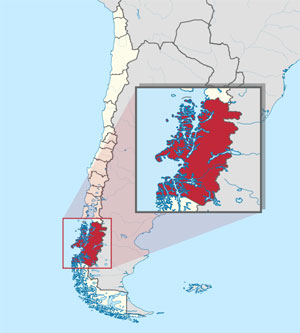
Aysen protest groups coalesced under the slogan “Aysen, your problem is my problem.” The government in Santiago received their demands on February 25. They are: accessible health care, increased minimum wage, reinstatement of dismissed public workers, a just pension system, local approval of “mega projects,” accessible university education, regional control of natural resources, empowerment of independent fishermen, subsidies for food, transportation, and fuel purchases, and policies protecting a “regionalized way of life.”
Isolation is at the root of most demands. Mountainous, wet, and non- agricultural Aysen is accessible only by sea or air. Living expenses are high.
Culminating a year of Chile’s most intense popular mobilizations since military rule ended in 1990, residents of Aysen, 1250 miles south of Santiago and 500 miles north of Tierra del Fuego, have been occupying streets and blocking highways. Beginning with independent fishermen on February 12, demonstrators in Aysen, Puerto Aysen, and Coyhaique have faced off against a government widely regarded as a regional bastion of globalized capitalism, one bolstered by ample military and police power.
The pace quickened after February 20 with daily demonstrations of up to 2000 people playing out in large towns. Aysen region’s population is 90,000. Militarized police known as “Carabineros,” flown in from afar, delivered tear gas, buckshot, and rubber bullets. Dozens have been wounded. A standoff February 24 at Ibañez Bridge near Aysen city between 3000 demonstrators and Carabineros lasted eleven hours.
The stage was set during 2011. Early that year social movements in adjourning Magellanes region protested high gas prices and overly centralized government. And students often joined by unionists repeatedly mobilized tens or hundreds of thousands of marchers demanding education for all, electoral system changes, and attention to people, not profits.
Indigenous people (“Mapuche” in Chile) protesting extreme poverty and corporate takeovers of ancestral land ended up in jail, a few of them on hunger strikes.
In Aysen, environmentalists and Mapuche protesters last year anticipated the current campaign with broadly supported agitation against eight hydroelectric dams proposed for the region. Swiss, Italian, Spanish, and Chilean corporations are behind a mega-project costing $5 billion for five dams which will flood 15,000 acres of pristine forestland. Cables would route electricity to Santiago and northern copper mines. Only in response to later complaints of high local electricity costs did planners envision mini-generators for Aysen.
Instead of sending certain ministers to Aysen for dialogue, as requested by the protesters, President Sebastián Piñera’s right wing government identified regional Intendant Pilar Cuevas as government negotiator. Local people, Puerto Aysen Mayor Marisol Martinez included, were incensed.
Not only is Cuevas accused of ties to ex-dictator Pinochet, but also her role epitomizes the much-despised centralization of Chilean state power. The Intendant, routinely appointed as top official in under-populated provinces, is responsible to the president making the appointment. Demonstrators also denounced Piñera’s government after Interior Minister Rodrigo Hinzpeter threatened a “state of siege.” He’s the author of a still-pending law aimed at criminalizing peaceful protests.
Labor unions, Mapuche organizations, leftist political organizations, and Amnesty International back the Aysen uprising. AI’s Chilean representative Ana Piquer critiqued the government’s “excessive use of force.” Copper workers union head Cristian Cuevas, visiting in Aysen, announced “a great national movement supporting regional demands in Chile” and “a nationwide outpouring of support for Aysen from labor and human rights organizations.” This last took place on February 27.
On February 22, Communist parliamentary deputy Hugo Gutiérrez visited Teófilo Haro in a Santiago Hospital. Haro, from Aysen, was hospitalized following loss of one eye at the hands of Carabineros. The next day at midnight in Aysen, Gutierrez and Catholic Bishop Luis Infanti de la Mora attempted to mediate between demonstrators and police. On February 24 in Coyhaique, Gutiérrez and Communist Party secretary Juan Catalán lodged a criminal complaint against Intendant Pilar Cuevas and other officials for police violence.
Catalán ran for mayor of Coyhaique recently for the Communist Party of Chile, which this year celebrates its 100 year anniversary.
Aysen Bishop Infanti de la Mora took the government to task in an interview: “This lack of [government] attention is the major violence to the Aysen region.” “Not only are they privatizing our wealth, but also decisions, dignity, and consciences of our people.”
His diocese operates Coyhaique-based Radio Santa Maria, much lauded for full, accurate reporting on the protests. According to piensachile.com, the station provides “a lesson for colleagues in Santiago.” Reporter Claudia Torres has become “a symbol for alternative radio by directly transmitting what’s happening in Aysen.”
Map: Aysen region, Chile. Wikimedia Commons.










